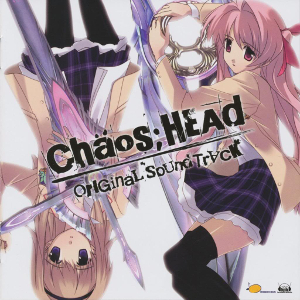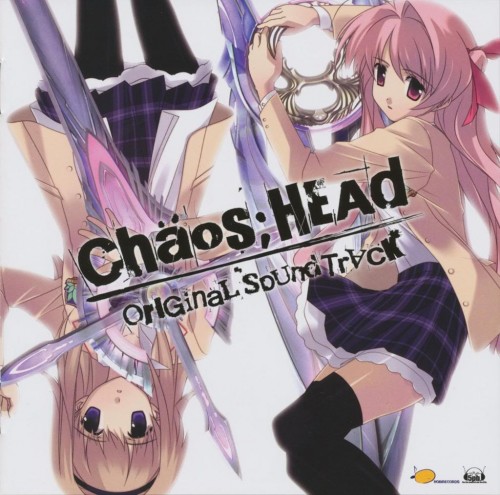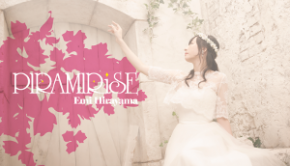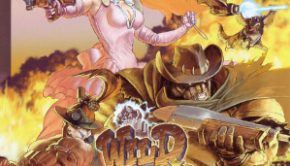Chaos;Head Original Soundtrack
 |
Album Title: Chaos;Head Original Soundtrack |
| Record Label: 5pb. Records |
|
| Catalog No.: FPBD-0073 |
|
| Release Date: July 4, 2008 |
|
| Purchase: Buy Used Copy |
Overview
A collaborative effort between Japanese developers 5pb and Nitroplus, Chaos;Head was a psychological thriller visual novel originally released for PC in 2008. Ports later followed for Xbox 360, PS3, PSP, iOS, and Android. Chaos;Head was never released outside of Japan, but an English patch for the PC and iOS versions was eventually made. The success of the title later led to the release of radio dramas, manga, and anime adaptions; as well as spin-off games and sequels which in turn started the Science Adventure series.
The story follows Takumi Nishijō, an otaku recluse who spends his days playing online video games, while suffering through intense delusions that affect his view of the world around him. One day, he witnesses a gruesome murderer and gets caught up in a series of incidents that will change his life forever. With an addictive plot full of twists and turns, it had me glued to my computer screen for hours at a time. Amazingly paced, professionally acted, and with a haunting sense of fear and dread; Chaos;Head was an experience unlike anything I’d ever seen in video games before. Of course, the game’s psychological atmosphere was immensely aided by the game’s soundtrack. The score was handled by a team of veteran visual novel composers consisting of Chiyomaru Shikura, Tatsushi Hayashi, Yoh Ohyama, Syntaro Jimbo, and Toshimichi Isoe; with Takeshi Abo responsible for most of the tracks. While those names aren’t household such as the likes of Uematsu, Sugiyama, or Kondo, members of the visual novel community will recognize some of these composers for their contributions to cult games such as Higurashi: When They Cry and the Infinity series. With all that said, is Chaos;Head a hit or is success just a delusion?
Body
A visual novel contains little to no actual interaction from the player. The large majority of “gameplay” spent is reading through vast amounts of text, while occasionally making a decision that affects the outcome of the story. 5pb and Nitroplus in particular are known for their high production values when it comes to these types of games and Chaos;Head is no exception with its sound design. The synth is of excellent audio quality with each track accurately painting the delusion-based world soundscape of the game.
The first disc on the album, titled the “Synchro Disc,” contains the music used for the game’s normal and less intense parts. Tracks like “SHIBUYA,” “I’m rounder,” and “Distorted Theory” all display Takeshi Abo’s signature use of electronica. These pieces are less melodic and lean towards scene-setting minimalist, but they’re all effective tracks nonetheless. “Detective” and “Truth and False” continue to expand on the electronica theme, notably having brighter synth with more presence. “In the ward” is one of the album’s more foreboding compositions, giving off feelings of uneasiness and worry. “Soliloquy,” on the other hand, feels slightly humorous; used during the game’s less serious scenes.
However Abo doesn’t simply stop at electronica. Rather, he expands his musical canvas with different styles. A highlight is the peppy and upbeat track “Girls” which has a catchy, memorable, and overall infectious melody. “Adventure” is another stand-out, being the theme for the protagonist’s online game. It is no doubt inspired by the RPG map overworld themes of the 16-bit era with its heroic orchestral synth and bombastic melody. A fitting and well-done homage all-around. Speaking of which, “Virtual Reality” is an interesting composition that’s an excellent throwback with its more retro-inspired sound.
Abo brings forth several melancholic themes as well. “M.I.L,” while being a simple piano track, is stunning in its composition and stirs memories from the game’s emotional scenes. “Pity” is another somber piano piece. The orchestra is comprised of obviously synthesized elements, but doesn’t feel overbearing or forced. “Tender hearts” is a love theme that feels affectionate and caring, representing the relationship between Takumi and the game’s lead female heroine. “Prologue” and “SHIBUYA -original-” are unused tracks, with the former being a brief electronic piece, while the latter merely using slightly different synth than the final version.
The second disc is the “Trigger Disc” referring the in-game decision-based system that allows the player to “choose” what delusions the protagonist can face. Choosing the green trigger will induce a “positive” fantasy, while selecting the red trigger causes a “negative” fantasy, usually involving a violent and gory situation. As a result, the music accompanying these delusions can range from intense to humorous.
Toshimichi Isoe, known for his work on other visual novels such as the Memories Off series and Symphonic Rain, contributes four tracks to the album. “Silence” and “Fear” are both similar sounding pieces that utilize chilling high-octave synth, not unlike the sound design used with Akira Yamaoka’s Silent Hill compositions. “Gradually Panic,” another one of Isoe’s, is a fast-paced chase theme that utilizes heavy piano keys and wailing saxophone towards the middle. “Mysterious” could have easily been a piece composed by Shinji Hosoe, sticking out in my mind as “dark electronica.” Breaking up these intense themes though, are more laid-back compositions by Takeshi Abo. “Delusion” is once again melodic, being a sleazy-sounding track used during Takumi’s more sexy and outlandish delusions. The melody is memorable, and it has a great rhythm. “SERIA,” the theme for Takumi’s imaginary “wife,” is a joy to listen to with the piece’s deep sensual synth, delectable melody, and jazzy composition. I especially enjoyed the section where the low bass joins in. “Delusion” and “SERIA” are some of my favorite themes on the soundtrack and are definitely must-listens. “Fear flow” and “The essence” are brooding and anonymous, again reminding me of Silent Hill. “Can see it?” changes things up by metamorphosing into a dance-beat techno theme mid-way through.
Yoh Ohyama brings forth three interesting tracks that all stand out differently. “Town Vanguard” is a strange fusion of Japanese and Middle Eastern instruments, but at times even sounds jazz-like. “Shogun,” the theme for Takumi’s mysterious online friend, is a sorrowful tune of piano paired with haunting synth. Finally, “Last Battle” sounds like an old-school boss battle theme with its odd combo of chiptune, organ, and piano. Syntaro Jimbo only provides a single track “White out” which is a rather repetitive piece that uses heavy percussion beats, while playing a few solitary electronic notes in between. It’s an interesting experimental track that’s effective in-game, but is of little interest otherwise.
Besides the game’s BGM themes, the album also includes the various vocal songs used throughout. Unfortunately, completionists looking for the full-length versions would be more satisfied tracking down the various single albums or the (more reasonable) complete vocal collection, as these tracks are shortened. Famed visual novel and anime singer Kanako Itō provides her voice for three of these songs. “Find the blue (Short Ver),” the game’s opening theme, is a powerful rock song that has stuck with me ever since I first played the game. The vocals are simply stunning, and the meaning behind the Japanese lyrics fits excellently with the game’s plot. “Desire Blue sky (Short Ver)” and “Cry (Full Ver)” are the game’s two ending themes both of which are a more soothing soft rock pieces. The latter is the notably the full version and not abridged. Itō’s performance with all three songs is excellent, and I highly recommend checking out the full versions of “Find the blue” and “Desire Blue sky” for the entire experience. Two other vocal songs are performed by Yui Sakakibara who voices FES, the lead singer of the in-game band Phantasm. “The Blood of the Contract for Our Sins (Short Ver)” and “Glajioul (Short Ver)” are J-rock pieces that have the standard components of the genre such as electric guitar, bass, and drums. There’s not much else to stay other than they’re both enjoyable songs that are great listens.
Summary
Chaos;Head doesn’t really break any new ground, but it can be best described as a collection of capable BGM themes and vocal songs. Listening through the entire soundtrack was truly a mind-warping experience. It surprisingly has an effective tapestry of styles, from electronica, ambience, RPG, and even jazz. Takeshi Abo’s compositions are the real star here, and at this point in his large-spanning career, I think he has truly mastered the art of composing visual novel BGMs that fit each scene. The rest of the composers also bring forth fitting tracks that all work well in-context. The vocal themes, on the other hand, are all great and memorable even if only the truncated versions are included. A certain appreciation for the electronica and J-rock must be had though, to fully enjoy this album on a stand-alone basis. Fans of the game will no doubt enjoy this album more than others, but anyone who’s a familiar with the composers’ previous works should also be satisfied.
Do you agree with the review and score? Let us know in the comments below!
4
Posted on March 14, 2014 by Oliver Jia. Last modified on January 17, 2016.
















Thanks for educating us on this series, Oliver.
No prob, Chris. : )
The Science Adventure series is really one of those franchises that few people know of outside of Japan. And the ones that do know about them are mostly only familiar with the anime. Hopefully JAST USA officially releasing Steins;Gate for PC will make it more popular.